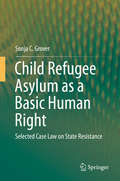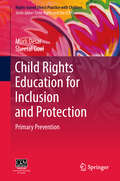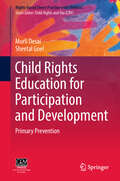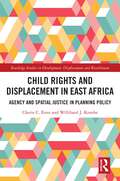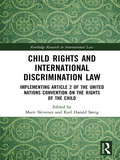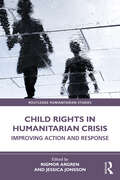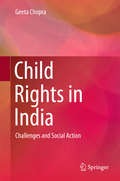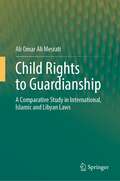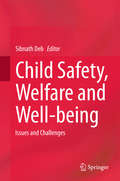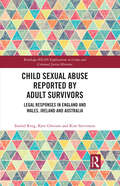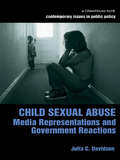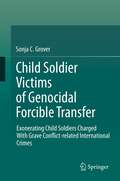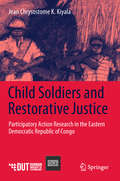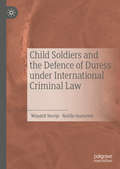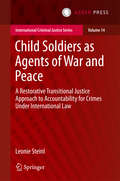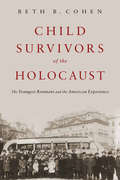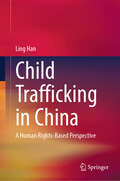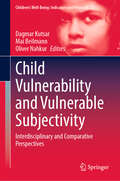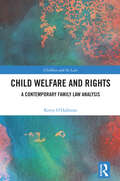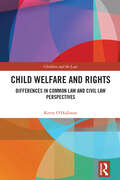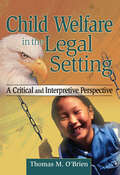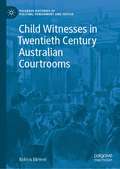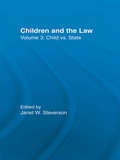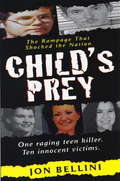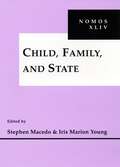- Table View
- List View
Child Refugee Asylum as a Basic Human Right: Selected Case Law On State Resistance
by Sonja C. GroverThis book addresses the intersection of various domains of international law (refugee law, human rights law including child rights international law and humanitarian law) in terms of the implications for State obligations to child refugee asylum seekers in particular; both as collectives and as individual persons. How these State obligations have been interpreted and translated into practice in different jurisdictions is explored through selected problematic significant cases. Further, various threats to refugee children realizing their asylum rights, including refoulement of these children through State extraterritorial and pushback migration control strategies, are highlighted through selected case law. The argument is made that child refugee asylum seekers must not be considered, in theory or in practice, beyond the protection of the law if the international rule of law grounded on respect for human dignity and human rights is in fact to prevail.
Child Rights Education for Inclusion and Protection: Primary Prevention (Rights-based Direct Practice with Children)
by Murli Desai Sheetal GoelThe aims of child rights education are to make children and their primary duty-bearers aware of child rights so that they both can be empowered to together advocate for and apply them at their family, school and community levels. This sourcebook focuses on child rights education for primary prevention related to inclusion and protection. Child rights education for exclusion, non-discrimination and inclusion is discussed in the context of family and society with reference to girls, children with disability, and Dalit and tribal children, and child rights to cultural and financial inclusion. Child rights education for protection comprises prevention of violence against children with reference to physical abuse/ corporal punishment and bullying, commercial exploitation of children with reference to child labour and trafficking and sale of children, sexual abuse and exploitation of children, problems in adolescent sexual relationships such as violence, teenage pregnancy, abortion and unwed motherhood, and sexually transmitted infections and HIV, child marriage, and conflict with law. This is a necessary read for social workers, lawyers, researchers, trainers and teachers working on child rights across the world, and especially in developing countries.
Child Rights Education for Participation and Development: Primary Prevention (Rights-based Direct Practice with Children)
by Murli Desai Sheetal GoelThe aims of child rights education are to make children and their primary duty-bearers aware of child rights so that they both can be empowered to together advocate for and apply them at their family, school and community levels. This sourcebook focuses on child rights education for primary prevention with reference to participation and development. The introductory chapter covers child rights values of peace, dignity, tolerance, freedom, equality and justice and child rights principles of dignity of the child, primary consideration to the best interests of the child, universality and non-discrimination, and state and societal accountability. Child rights to participation focuses on child rights for playing a decisive and responsible role in their own life and a participatory role in the family, schools, associations, community and with the state as citizens. Child rights to development includes child rights to free, compulsory, comprehensive and quality education, free of discrimination and violence; child rights to play, recreational, cultural, and artistic activities and media literacy; child rights to health with reference to physical health and hygiene, healthy and hygienic food and nutrition, sexual health and prevention of substance abuse; and child rights to environmental education with reference to child rights to environmental harmony and hygiene and child rights to sustainable environment. This is a must-read for researchers, trainers, and other professionals working on child rights issues across the world, and especially in developing countries.
Child Rights and Displacement in East Africa: Agency and Spatial Justice in Planning Policy (Routledge Studies in Development, Displacement and Resettlement)
by Cherie C. Enns Willibard J. KombeFocusing on the intersection of spatial justice, child rights, and planning policy, this book investigates the challenges of resettlement in East Africa, where half of those displaced are children. The challenges created by displacement and resettlement are often considered from an adult-centric perspective by planners and humanitarian and development experts. The spatial injustice of displacement and resettlement, the agency of children, and the application of tools such as Child Participatory Vulnerability Index (CPVI) is siloed, commonly overlooked, or discounted. This book uses a CPVI and rights-based assessment of land-use policies, to investigate resettlement due to conflict and settlement in northern Uganda, floods due to climate change in Dar es Salaam, Tanzania, and urban to rural migration of children due to the aids pandemic in Western Kenya. Case studies from over a decade of field research are integrated with examples from applied planning projects and policy development in the East Africa region. This book uses spatial justice theory to show how child-friendly planning approaches can positively promote child rights in the context of resettlement. Providing important insights on how to enact child-friendly planning in informal settlements, refugee camps, and displacement camps, this book will be of interest to planning and development professionals, and researchers across the fields of children's rights, Development Studies, Planning, and African Studies.
Child Rights and International Discrimination Law: Implementing Article 2 of the United Nations Convention on the Rights of the Child (Routledge Research in International Law)
by Marit Skivenes Karl Harald SøvigSocieties and states are at a crossroad in how children are treated and how their rights are respected and protected. Children´s new position and their strong rights create tensions and challenge the traditional relationships between family and the state. The United Nations Convention on the Rights of the Child was adopted unanimously by the General Assembly of the United Nations in 1989 and came into force in 1990. Article 2 places states under an obligation to accord primacy to the best interests of the child in all actions concerning children and to ensure and regulate child protection. This book offers a comparative and critical analysis of the implementation of Article 2 of the United Nations Convention on the Rights of the Child. In order to examine how Article 2 is being implemented, it is essential to have a sound understanding of the obligations it emposes. The opening chapters will explore the precise content of these obligations in terms of the legislative history of the text, its underlying philosophy, its amplification by the United Nations Committee on the Rights of the Child, and subsequent authoritative interpretations of it by courts around the world. The book will then drill down into the conceptual and theoretical challenges posed by the very nature of the obligations and will offer in-depth exploration of the long-running ‘rights v welfare’ debate that has always presented something of a challenge in giving effect to children’s rights. Contributors are leading academics in the children’s rights field drawn from a wide range of countries and jurisdictions worldwide, including those with common law, civilian and mixed traditions. Disciplines represented in the book include law, psychology, political science, childhood studies, social work and anthropology. By drawing together the various facets of Article 2 and analysing it from a range of perspectives, the volume provides a coherent and comprehensive inter-disciplinary analysis on discrimination and the rights of the child.
Child Rights in Humanitarian Crisis: Improving Action and Response (Routledge Humanitarian Studies)
by Rigmor Argren Jessica JonssonThis book demonstrates how a focus on children’s rights can help practitioners to safeguard children during humanitarian crisis. Child Rights in Humanitarian Crisis focuses on understanding and advancing child rights through practical applications of a child rights perspective in crisis response. The book establishes that with accessible, child-friendly participatory means, crisis response can improve from a child rights perspective and even advance children’s rights whilst also supporting and furthering the development of a child’s agency. The volume presents the reader with a clear focus on children from a range of backgrounds, including those most marginalised, such as children with disabilities. Drawing on expertise from the field as well as academia, and providing practical examples which link case studies to legal policies in recent and protracted humanitarian responses, such as in Turkey and at the Lithuania–Belarus border, this book is a treasure trove of advice from some of the humanitarian and development sector’s most experienced professionals. Combining insights from both research and practice, this book will be an essential read for humanitarian students and practitioners.
Child Rights in India: Challenges and Social Action
by Geeta ChopraThe book is a comprehensive compendium on child rights in India from a child development perspective. It discusses the challenges that Indian children face for survival, development and education, especially if they are marginalized through disability, lack of care, and poverty. The major issues expounded by the author in relation to rights are infant and child survival, early child development, street and working children, children in conflict with law, children with disabilities, child trafficking and child sexual abuse. The author goes further to delve into the causes, among which are high population, poverty, migration, illiteracy, poor legislation and deep-rooted social norms and behaviour. The book presents the existing policy and legal framework in India for each of these issues. The broad purpose of the book is to comprehensively discuss the roadblocks that the marginalized child in India faces, to understand the causes of these roadblocks and to evaluate government and civil society action for children in India.
Child Rights to Guardianship: A Comparative Study in International, Islamic and Libyan Laws
by Ali Omar MesratiThis book examines how local cultures affect the interpretation of international human rights law. This book explores the Islamic legal system in its approach to the concept of guardianship and, more specifically, the approach of the Libyan legal system through a study of existing legislation and Libyan High Court (LHC) interpretation as revealed in its decisions. This book aims to show how the cultural background affects the interpretation of international human rights in domestic legal systems. This book makes a worthy contribution to promoting greater understanding of the cultural dimensions in operation in both the formulation and particularly the application of international law in Libya as elsewhere. This is an area of research which is, as a whole, one worthy of further development and examination. The book includes case analysis of important Libyan High Court rulings which have been gathered by the author and officially translated, analysed, and discussed from the three lenses namely; Libyan Law, Islamic Law, and International Law. In turn, this book is the first of its kind and unique in the field of Islamic and International Law. This book also includes detailed analysis of the correspondence between the Libyan High Court and the UN Committee on the Rights of the Child. Further, this book provides solutions and comprehensive and practical recommendations that satisfy both International standards and local Islamic and Libyan culture. This is an ever evolving and a current area of interest internationally, this unique book enriches the field and continues the conversation and provides practical sustainable solutions.
Child Safety, Welfare and Well-being: Issues and Challenges
by Sibnath DebThis volume presents the unique features of child abuse and neglect and discusses proposed as well as experimented protective measures to create awareness about child rights and their implementation. Divided into four sections, the volume discusses (a) the nature and prevalence of child abuse and neglect, risk factors and impact; (b) issues pertaining to child rights with regard to nutrition, health and education; (c) rights of children with disabilities, HIV/AIDS, and in circumstances like disaster and adoption; and (d) field-based experiences of researchers in protecting child rights and preventing child abuse. The most important contribution of this volume is in providing an analysis of the current legal scenario of child protection, emphasizing the rights of different sections of vulnerable children. Professionals and academics specializing in this area from different academic backgrounds and regions have contributed chapters to this volume, creating a global and multidisciplinary forum for discussion. This volume is important for a wide range of professionals and researchers from the social sciences, law, medicine, and behavioral sciences. It is also beneficial for policy makers and law enforcement agencies working with children.
Child Sexual Abuse Reported by Adult Survivors: Legal Responses in England and Wales, Ireland and Australia (Routledge SOLON Explorations in Crime and Criminal Justice Histories)
by Kim Stevenson Sinéad Ring Kate GleesonChild Sexual Abuse Reported by Adult Survivors is a wide-ranging and timely critical history and analysis of legal responses to ‘historical’ or ‘non-recent’ child sexual abuse (NRCSA) in England and Wales, Ireland and Australia, each of which represents an evolving and progressive approach to this important and complex issue. The book examines the emergence of NRCSA as a distinctive social, political and legal phenomenon in each country and explores the legal responses developed to address its unprecedented challenges. Courts and parliaments in each country have reformed existing doctrine and practice and have created new ways of holding state and private actors accountable and new ways of addressing survivors’ injuries. Criminal law, tort law, public inquiries and state reparations have all been to the forefront of these new legal responses, which have transformed law’s engagement with NRCSA survivors and understandings of justice itself. However, despite this undeniable progress, the book identifies ways in which the legal responses developed in each country fail to deliver accountability and recognition to NRCSA survivors and argues that such failures betray the law’s inherent ambivalence to delivering justice for these survivors. Creating new insights into legal responses to this complex contemporary legal, social and political problem, this book will be of great interest to academic lawyers, political scientists and historians, as well as those working on related topics in criminology, sociology, social policy, cultural studies and gender studies.
Child Sexual Abuse: Media Representations and Government Reactions (Contemporary Issues in Public Policy)
by Julia DavidsonChild Sexual Abuse critically evaluates the development of policy and legislative measures to control sex offenders. The last fifteen years has seen increasing concern on the part of the government, criminal justice agencies, the media and the public, regarding child sexual abuse. This concern has been prompted by a series of events including cases inviting media attention and involving the abduction, sexual abuse and murder of young children. The response to this wave of child sexual abuse revelation has been to introduce increasingly punitive legislation regarding the punishment and control of sex offenders (sex offenders are the only group of offenders in British legal history to have their own act), both in custody and in the community. But this response, it is argued here, has developed in a reactionary way to media and public anxiety regarding the punishment and control of sex offenders (who have abused children) and the perceived threat of such offenders in the community.
Child Soldier Victims of Genocidal Forcible Transfer: Exonerating Child Soldiers Charged With Grave Conflict-related International Crimes
by Sonja C. GroverThis book provides an original legal analysis of child soldiers recruited into armed groups or forces committing mass atrocities and/or genocide as the victims of the genocidal forcible transfer of children. Legal argument is made regarding the lack of criminal culpability of such child soldier 'recruits' for conflict-related international crimes and the inapplicability of currently recommended judicial and non-judicial accountability mechanisms in such cases. The book challenges various anthropological accounts of child soldiers' alleged 'tactical agency' to resist committing atrocity as members of armed groups or forces committing mass atrocity and/or genocide. Also provided are original interpretations of relevant international law including an interpretation of the Rome Statute age-based exclusion from prosecution of persons who were under 18 at the time of perpetrating the crime as substantive law setting an international standard for the humane treatment of child soldiers.
Child Soldiers and Restorative Justice: Participatory Action Research in the Eastern Democratic Republic of Congo
by Jean Chrysostome KiyalaThis book investigates how, while children used as soldiers are primarily perceived as victims of offences against international law, they also commit war atrocities. In the aftermath of armed conflict, the mainstream justice system targets warlords internationally, armed groups and militias’ commanders who abduct and enrol children as combatants, leaving child perpetrators not being held accountable for their alleged gross human rights violations. Attempts to prosecute child soldiers through the mainstream justice system have resulted in child rights abuses. Where no accountability measures have been taken, demobilised young soldiers have experienced rejection, and eventually, some have returned to soldiering. This research provides evidence of the potential of restorative justice peacemaking circles and locally-based jurisprudence – specifically the Baraza - to hold former child soldiers accountable and facilitate their reintegration into society.
Child Soldiers and the Defence of Duress under International Criminal Law
by Windell Nortje Noëlle QuénivetThis book investigates the use of duress as a defence in international criminal law, specifically in cases of child soldiers. The prosecution of children for international crimes often only focuses on whether children can and should be prosecuted under international law. However, it is rarely considered what would happen to these children at the trial stage. This work offers a nuanced approach towards international prosecution and considers how children could be implicated and defended in international courts. This study will be of interest to academics and practitioners working in international criminal law, transitional justice and children’s rights.
Child Soldiers as Agents of War and Peace: A Restorative Transitional Justice Approach to Accountability for Crimes Under International Law (International Criminal Justice Series #14)
by Leonie SteinlThis book deals with child soldiers' involvement in crimes under international law. Child soldiers are often victims of grave human rights abuses, and yet, in some cases, they also participate actively in inflicting violence upon others. Nonetheless, the international discourse on child soldiers often tends to ignore the latter dimension of children's involvement in armed conflict and instead focuses exclusively on their role as victims. While it might seem as though the discourse is therefore beneficial for child soldiers as it protects them from blame and responsibility, it is important to realize that the so-called passive victim narrative entails various adverse consequences, which can hinder the successful reintegration of child soldiers into their families, communities and societies. This book aims to address this dilemma. First, the available options for dealing with child soldiers' participation in crimes under international law, such as transitional justice and criminal justice, and their shortcomings are analyzed in depth. Subsequently a new approach is developed towards achieving accountability in a child-adequate way, which is called restorative transitional justice. This book is in the first place aimed at researchers with an interest in child soldiers, children and armed conflict, as well as international criminal law, transitional justice, juvenile justice, restorative justice, children's rights, and international human rights law. Secondly, professionals working on issues of transitional justice, juvenile justice, international criminal law, children's rights, and the reintegration of child soldiers will also find the subject matter of great relevance to their practice. Dr. Leonie Steinl, LL. M. (Columbia) is a Researcher and Lecturer at the Faculty of Law of the Humboldt-Universit#65533;t in Berlin.
Child Survivors of the Holocaust: The Youngest Remnant and the American Experience
by Dr Beth B. CohenThe majority of European Jewish children alive in 1939 were murdered during the Holocaust. Of 1.5 million children, only an estimated 150,000 survived. In the aftermath of the Shoah, efforts by American Jews brought several thousand of these child survivors to the United States. In Child Survivors of the Holocaust, historian Beth B. Cohen weaves together survivor testimonies and archival documents to bring their story to light. She reveals that even as child survivors were resettled and “saved,” they struggled to adapt to new lives as members of adoptive families, previously unknown American Jewish kin networks, or their own survivor relatives. Nonetheless, the youngsters moved ahead. As Cohen demonstrates, the experiences both during and after the war shadowed their lives and relationships through adulthood, yet an identity as “survivors” eluded them for decades. Now, as the last living link to the Holocaust, the voices of Child Survivors are finally being heard.
Child Trafficking in China: A Human Rights-Based Perspective
by Ling HanThis book provides a comprehensive view to those who are interested in human trafficking, child trafficking, and child protection in China. Based on over 2000 case laws from 1990 to 2020, this book provides an in-depth analysis of the causes, criminal patterns, and consequences of child trafficking happened in 30 provinces in China. It reveals a phenomenon that has not attracted much attention at the international level -- the trafficking of children, intranational and transnational, for resale and illegal adoption.
Child Vulnerability and Vulnerable Subjectivity: Interdisciplinary and Comparative Perspectives (Children’s Well-Being: Indicators and Research #27)
by Dagmar Kutsar Mai Beilmann Oliver NahkurThis book explores child vulnerability in various contexts from a cross-country, comparative perspective. It shows how vulnerability in childhood develops within subjects in relationships with other people (other children, parents, specialists, such as teachers, social workers, and judges), how it is created by welfare, health care, education, and justice systems, and is empowered by multiple crises, such as the COVID-19 pandemic, wars and natural disasters. The authors hope to enhance dialogue between childhood studies and children’s rights studies through these discussions. The role of children’s agency and autonomy, including their right to participate in decision-making processes related to their own life, has a special emphasis in this book. Importantly, the book discusses ethical considerations and challenges connected to the participation of vulnerable children in research. It also adds insights into domain-based child vulnerability, particularly through participatory action research with extremely vulnerable children with traumatic pasts in Estonian substitute care and Ukrainian children with refugee status in Estonia. The book thereby provides deep insights into the ways to increase child well-being by decreasing vulnerabilities and building resilience. It combines approaches from psychology, sociology, law, educational sciences, social work, and media studies, and is an important resource for academics as well as practitioners and policy-makers working on children's well-being.
Child Welfare and Rights: A Contemporary Family Law Analysis (Children and the Law)
by Kerry O'HalloranThis book focuses on the role and content of the principle of the welfare interests of the child, considers the extent to which the principle has changed following its varied elevation by the introduction of paramountcy and reviews the distinction between welfare interests and rights.Providing an updated record of developments in the framework of relevant international law, the book assesses the contemporary relevance of established and emerging themes in the flow of cases dealing with the welfare interests and rights of children in England, Wales, Ireland, the U.S., Canada, Australia, New Zealand, France and Germany. By identifying and analysing the functions of the principle in hybrid proceedings (including adoption from state care and commercial surrogacy) the book completes the analysis of the law relating to children in public (care and protection) and in private (divorce, custody, etc.) family law as a whole, revealing characteristic jurisdictional differences and facilitating a comparative assessment of their significance. By examining the international framework of legislation and related caselaw it identifies and assesses unfolding themes in the law relating to children. In addition to a digest of international cases and legislation that identifies and tracks the role of this principle in civil and criminal law, lawyers, academics and other researchers will find a wealth of information on how it has evolved to reflect corresponding changes in society.
Child Welfare and Rights: Differences in Common Law and Civil Law Perspectives (Children and the Law)
by Kerry O'HalloranThis book examines jurisdictional differences in the role of the principle of the welfare interests of the child in common and civil law and focuses on differences within these two legal traditions.By identifying and analysing the functions of the principle both in the public and private sector of family law, the book compares and contrasts different jurisdictions and assesses their capacity to implement children’s welfare interests and rights. Covering a variety of topics including child abuse and neglect, state care, adoption and reproductive rights and family breakdown, the book demonstrates how welfare interests and rights can be balanced to create a coherent framework for family law.In addition to providing an up-to-date digest of cases and legislation, the book will be of interest to researchers in the field of child welfare and family law.
Child Welfare in the Legal Setting: A Critical and Interpretive Perspective
by Thomas M O'BrienExplore legal issues that often hinder the work of child welfare practitioners! Child Welfare in the Legal Setting: A Critical and Interpretive Perspective is a revolutionary study of the child welfare system that is essential for practitioners, educators, and students interested in public child welfare work. It examines the legal system surrounding child welfare workers and highlights their need for agency-specific training. This insightful book challenges the traditional rules of child welfare and paves the way for alternate methods of conceptualizing and organizing child protection. It explores why many family interventions fail and others never even occur. By identifying incongruities between the philosophy of child welfare and its function, this book advocates a more individualistic and efficient technique for assisting clients. Addressing issues and challenges from the initial identification of problems to navigating the legal system, this book is also thorough enough for public child welfare workers who want to take their skills to the next level. The large-system perspective in this book uses the concentric circle model, the rational legal model of legal and court action, and the ritualized process model to examine child welfare practice. Learn why terms such as "child abuse" and "neglect" have become social constructions that vary depending on the values of social workers, judges, attorneys, agencies, and communities. Child Welfare in the Legal Setting: A Critical and Interpretive Perspective examines the standardization of the organizational activities of child welfare systems and how this limits professionals&’ ability to accurately recognize unique problems and intervene in the most beneficial manner. Child Welfare in the Legal Setting also provides controversial opinions on emerging issues including: family investigations sanction for Child Protective Services intervention the legal setting as a host environment the function of the child welfare system rationalization of child welfare intervention "trained incapacity" of social workers Title IVE programs the court system Child Welfare in the Legal Setting: A Critical and Interpretive Perspective identifies vital issues by analyzing the ethical and moral foundations of the child welfare system. This insightful book also takes a close look at how practitioners inadvertently devalue their clients by using language that creates stigmatized social categories such as "victim" and "convicted felon." Supervisors, managers, social workers and child welfare practitioners will benefit from this information. The vignettes that supplement the narrative also make the book an important resource in any child welfare course.
Child Witnesses in Twentieth Century Australian Courtrooms (Palgrave Histories of Policing, Punishment and Justice)
by Robyn BlewerThis book considers the law, policy and procedure for child witnesses in Australian criminal courts across the twentieth century. It uses the stories and experiences of over 200 children, in many cases using their own words from press reports, to highlight how the relevant law was – or was not - applied throughout this period. The law was sympathetic to the plight of child witnesses and exhibited a significant degree of pragmatism to receive the evidence of children but was equally fearful of innocent men being wrongly convicted. The book highlights the impact ‘safeguards’ like corroboration and closed court rules had on the outcome of many cases and the extent to which fear – of children, of lies (or the truth) and of reform – influenced the criminal justice process. Over a century of children giving evidence in court it is `clear that the more things changed, the more they stayed the same’.
Child vs. State: Children and the Law (Controversies in Constitutional Law)
by Janet W. Steverson"First Published in 2002, Routledge is an imprint of Taylor & Francis, an informa company."
Child's Prey
by Jon BelliniSchool Slaughter At 8 a. m. on Wednesday October 11997 nerdy overweight outcast Luke Woodham16 entered his Pearl Mississippi high school to settle some scores. Armed with a . 30-30 hunting rifle he opened fire and then calmly walked out of the school door leaving two teenage girls dead and another seven students seriously wounded. Police soon discovered that Woodham's 11-minute rampage had actually begun hours before at home where they found his mother Mary Anne brutally beaten with a baseball bat and then stabbed to death. Evil CultLuke Woodham may have been the assassin but behind his horrifying act lay the shadowy hand of a twisted mastermind. Grant Boyette18 Bible student-turned-Hitler-lover and devil-worshipper was a diabolical Pied Piper who used a fantasy role-playing game to program six high school students with hate Satanism and animal torture. "Murder Is Gutsy And Daring. "Those were the chilling words of Luke Woodham now serving three consecutive life sentences. The horror he unleashed serves as a disturbing reminder of today's shocking epidemic of high school shootings and that the one place America's kids are supposed to be safe has become the most dangerous place of all. 16 Pages Of Shocking Photos!
Child, Family and State: NOMOS XLIV
by Stephen MacedoIn an era in which our conception of what constitutes a “normal” family has undergone remarkable changes, questions have arisen regarding the role of the state in “normalizing” families through public policy. In what ways should the law seek to facilitate, or oppose, parenting and child-rearing practices that depart from the “nuclear family” with two heterosexual parents? What should the state's stance be on single parent families, unwed motherhood, or the adoption of children by gay and lesbian parents? How should authority over child rearing and education be divided between parents and the state? And how should the state deal with the inequalities that arise from birthright citizenship? Through critical essays divided into four parts-Adoption, Race, and Public Policy; Education and Parental Authority; Same Sex Families; and Birthright Citizenship-Child, Family, and State considers the philosophical, political, and legal dilemmas that surround these difficult and divisive questions. An invaluable resource in these contentious debates, Child, Family, and State illuminates the moral questions that lie before policymakers and citizens when contemplating the future of children and families.
